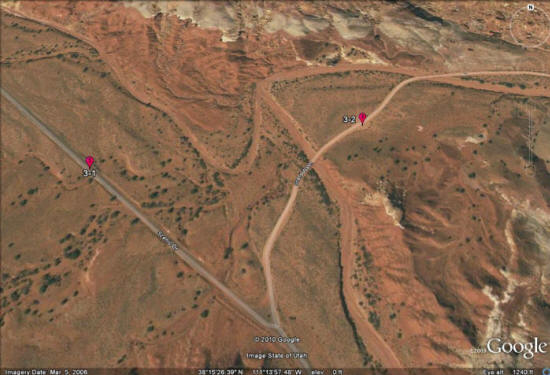Day 3, Stop 1
Wingate Sandstone
GPS Location:
38o 15.452' N
111o 14.087' W
Ages:
Lower Jurassic
Rock Units:
Wingate Sandstone
Features Present:
Although the Wingate Sandstone is typically reddish in color, due to the precipitation of iron oxides in the spaces between the individual sand grains. This red coloration can happen with subaerial exposure at the Earth’s surface during or shortly after deposition, or even later when the rock has been buried (part of the digenetic process).
Sometimes the Wingate Sandstone has a light, buff color from the bleaching of iron oxide stained sandstone. Fluids such as hydrocarbons with the ability to reduce iron oxide are critical to the bleaching process (Parry et al. 2004). Bleaching in much of the Navajo Sandstone is due to its relatively high permeability allowing fluids to flow through the rock, and is believed to indicate that the Navajo was once a significant hydrocarbon bearing formation (Beitler et al. 2003). The lack of bleaching in the Wingate Sandstone is a potential indicator that it is not as permeable to large-scale fluid flux (compared to the Navajo Sandstone).
Locally areas of bleaching are present in the Wingate cliffs to the east of Scenic Dr, south of the park visitor center, in the vicinity of the Oyler Mine. In this locality, the lowermost portions of the Wingate (those directly above the Chinle Formation), appear to be bleached. A possible explanation for this bleaching is that the relatively impermeable mud-rich intervals of the Chinle Formation locally forced increased fluid flow in the lower most Wingate Sandstone. Fluids traveling downward through the Wingate Sandstone could not likely continue down into the Chinle, and would therefore have to travel along the boundary between the two formations to create a zone of increased fluid flow in the lower portions of the Wingate Sandstone.
Depositional Environment:
Eolian


Figure 1: View from Scenic Dr. of the Wingate Sandstone. The lowermost portion of the Wingate Sandstone is bleached while the upper portion of the formation retains red coloration. Contacts between the bleached and unbleached portions of the Wingate and between the Wingate Sandstone and Chinle Formation are indicated by black lines.
